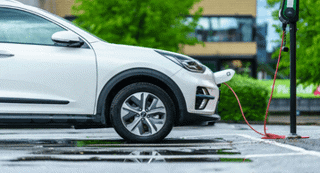Senior managers at Balfour Beatty, including both the fleet director and managing director of Plant and Fleet Services, are trialling telematics in their company cars to assess the technology’s benefits.
Telematics is already fitted to Balfour Beatty Plant and Fleet Services’ 2,000-plus vans, but it is currently only installed in company cars if the driver is deemed ‘high risk’.
“As a company car driver I will get telematics in my vehicle if I’m under 23 years of age, if I’ve had a drink-drive ban in the last five years or if I’ve held my licence for less than 12 months,” said Robert Lindsay, driver risk manager at Balfour Beatty Plant and Fleet Services (pictured), who was speaking at the annual Brake Fleet Safety Conference.
Cash allowance drivers also have telematics installed in their vehicle if they are deemed high risk.
“If they have been given an allowance to buy their own car it’s the same principal as a company car,” Lindsay said. “There are certain categories that we are suggesting are high risk and therefore we are going to use telematics as one of the tools to mitigate that risk.”
Currently, approximately 120 cars have telematics installed and Balfour Beatty is now “exploring other possible benefits” that could come from the widespread use of telematics across the company car fleet.
“It might not be the full lights on the dashboard and all the bells and whistles, it might be something that supports the driver with their expense claims or helps the business from a VAT or tax perspective,” Lindsay said. “We’d like to try and get it in from a safety benefit point of view because we’ve seen with the commercial vehicles that it’s of value.”
Since the end of last year, 12 senior managers and ‘strategic stakeholders’ (e.g. those working in health and safety or risk roles) across different Balfour Beatty businesses, including Plant and Fleet Services, Power Transmission and Distribution, and Rail UK, have been voluntarily trialling telematics in their personal company cars.
Lindsay has had telematics in his company car for a number of years.
“I would recommend that fleet managers do that because it allows you to understand telematics,” he said. “You can analyse your own data and it gives you an understanding of what the thresholds are.
“If I see someone with 1,000 harsh braking incidents I know that that is really hard to do, so therefore we need to do something about that person, whereas if I see someone that gets no incidents after 20 hours of driving I think ‘that’s pretty impressive, well done’.”
Lindsay suggested that it also makes it easier for line managers to have conversations with drivers.
“It really empowers you when you’re in that position,” he said. “You understand the technology’s benefits and its pitfalls and you can speak with authority.
“You’re also seen to be ‘practising what you preach’. If a driver argues that it’s one rule for commercial vehicles and another for cars you can dispel that myth quite quickly.”
Drivers that consistently get poor telematics scores are given a risk scoring, which is based on the number of incidents of harsh braking, cornering, accelerating or speeding they have had divided by their driving time. Those drivers then have on-road coaching and attend an in-house speed awareness course.
Young drivers have proved receptive to having telematics in their company car.
“It’s a lot easier for young drivers to get their heads round it because they’re seeing it with their own private insurance so it’s an easier sell than people who have been driving for 30 years and don’t perhaps understand the technology,” Lindsay said.
“There is no quick way of getting driver buy-in; you’ve got to keep plugging away at it. Be open and honest about why you’re introducing telematics and have some guides that you can give to managers and drivers. You’ve got to have the confidence that it is the right thing to do.”





















Sage & Onion - 03/06/2015 13:48
It also helps to fit privacy switches on trackers or telematics in company cars to overcome the most common objections of invasion of privacy. But then you have to manage how the privacy switch is used to avoid it being abused. Its a good idea to fit them to high risk drivers but the high risk identifiers explained in the article aren't very complex but its a good place to start. I think its better to fit telematics to all company vehicles and then use the risk scores recorded by the system as the datum for implementing other risk-reducing initiatives such as driver training or fitting in-cab cameras etc .